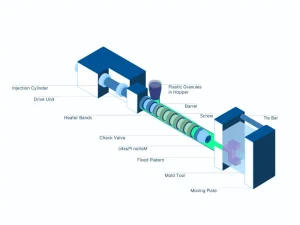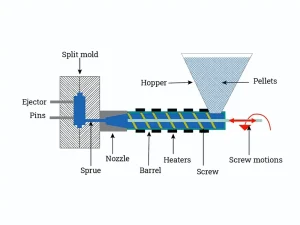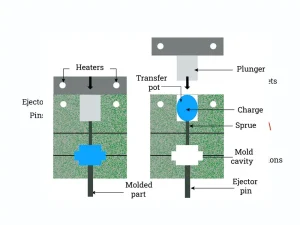Nowadays, plastic and rubber products are predominant. Several production methods produce these products. However, compression and injection molding are the most popular methods. Some people consider the compression process more favorable, while others prefer injection molding. This debate led me to write about compression vs injection molding.
These two molding methods vary in many terms. Knowing the difference is crucial before starting a rubber or plastic project. Are you among those who are unaware of their differences? Worry not! This comprehensive guide will discuss the significant comparisons between these methods. So let’s get started!
Overview of Compression and Injection Molding

Injection and compression molding are used to make various rubber and plastic products. The compression molding method is old and compromised in terms of precision. However, the injection molding method is quick, modern, and precise. It can help produce bulk products quickly.
These two production processes differ in many ways. For example, the material’s tiny pieces are placed in the mold chamber in compression molding. This chamber has a cavity of the desired shape. When pressure and heat are applied, the raw material melts. This melted material flows and fills the cavity of the mold.
After some time, it cools down and takes on the shape of the mold cavity. In the end, rigid plastic or rubber products are made. They can be used for various applications. Conversely, injection molding uses already melted material. The plastic or rubber material is melted at a high temperature during the initial phase.
After that, this molten material is injected into a mold with specific cavities. After some time, the curring (cooling) process takes place, and the final product is obtained. It is crucial to put the melted material into the mold cavity before it cools.
It will be useless if the molten material cools down before reaching the mold cavity. The mold used in production requires special attention. It must be similar to the product you want to get. The molten material solidifies to adopt the shape of the mold. Using the wrong mold will give you the wrong product shape.
Differences between Compression and Injection Molding
The overview gave you the basic idea of both molding methods. However, knowing the difference between the two methods is crucial before using any method. So, let’s dive into their detailed comparison of these methods and see what sets them apart.
1- Process Complexity

Both injection and compression molding vary in terms of complexity. Compression molding involves simple steps. HOW? This process needs a measured amount of plastic or rubber in the form of powder. The mold cavity contains this powder, and a hydraulic cylinder applies pressure.
Due to heat and pressure, the powder melts and fills the mold cavity. On cooling, a durable plastic or rubber product is formed. On the other hand, injection molding is a complex process. For example, a high temperature is required for the pre-melting of the raw materials.
The product will be uneven and useless if it cools down before reaching the mold cavity. The mold used in production requires special attention. They must be similar to the product you want to get. The molten material solidifies to adopt the shape of the mold. Using the wrong mold will give you the wrong product shape.
2- Cycle Time and Production Efficiency
Cycle time indicates the time taken by the complete molding procedure. The cycle time of the injection molding process is short compared to compression. The injection machine quickly melts the material and injects it into the mold through the injection unit. Moreover, the solidifying procedure is also fast due to various modern cooling channels.
The whole process after the material is injected takes a few minutes. Due to the shorter cycle time, the production efficiency is also excellent. You can quickly produce a large number of products. On the other hand, compression molding has an extended cycle time. The raw material takes time to melt in the mold cavity.
The reason is that a moderate amount of heat is provided in the mold chamber. Moreover, the solidification process also takes time. Overall, the compression molding takes several hours to complete. Due to slower steps, the production efficiency of this process is also not good. This process cannot manufacture large-scale products.
3- Tooling and Setup Time
Compression molding requires simple machinery consisting of a heater and pressing tools. All these tools are easy to operate and set. However, one drawback of the tooling setup is that you must change the whole setup after every cycle. This change in setup occurs manually every time. Its tooling setup is easy, but it is time-consuming due to repetition.
On the other hand, injection molding requires complex tools. For example, it needs a pressure reliever, an injecting unit, and various complex molds. All these tools need time to set up. Once they are set up correctly, you don’t need to change them after a cycle. This permanent setup not only saves your time but also ensures precision.
4- Maintenance and Wear
As I said above, the compression molding method requires simple machinery. Therefore, it has less chance of wear and is easy to maintain. Moreover, the design of molds in this procedure is straightforward. They can withstand the pressure of hydraulic cylinders. Contrarily, injection molding is a complicated procedure.
It requires standard tools such as injecting units and pressure relievers. Moreover, the molds’ complex and intricate designs are also prone to wear. The injection of material that has melted to a high degree in the mold can also affect its structure. Overall, the injection molding process requires more maintenance and tool replacement.
5- Material Compatibility

Both compression and injection molding vary in terms of material compatibility. The compression molding procedure is more compatible with thermosetting plastics. Do you know what thermosetting plastic is? These plastics become so hard after molding that they can’t be melted or molded again.
Simply put, these are irreversible plastics. Therefore, compression molding is suitable for manufacturing vehicle body parts. Conversely, the injection molding process is versatile for many materials. This process can easily handle elastomers and thermoplastics. Examples of thermoplastics include nylon and polyethylene.
These plastics are reversible and can be molded again and again. Hence, this injection molding produces delicate parts of automobiles and medical devices. Remember, injection molding machines can also work with thermosetting plastics. This indicates that this method of production is very satisfactory.
6- Environmental Impact
Honestly speaking, both molding procedures impart some environmental effects. However, the extent of these effects varies in each process. For example, injection molding is an energy-consuming method. It takes more energy-consuming tools to melt and cool the material for high precision.
You know that the injection molding process produces recyclable products. These products can be reused multiple times, which demonstrates their environmental friendliness. On the other hand, compression molding uses a simple machinery setup. It does not need high-energy-consuming tools for melting and cooling.
Therefore, this process is more energy efficient overall. It also produces less material waste than injection molding. However, its thermosetting products are not eco-friendly. They can’t be recycled or reused, so they pollute the environment and harm living things.
7- Tooling Costs
I have mentioned above that both molding procedures use various tools. Compression molding produces simple design products. Thus, it needs simple and inexpensive tools. The machine used in this method is also straightforward and has limited functionality. Remember, you cannot make complex geometric products with this procedure.
On the flip side, the injection molding procedure uses particular tools. Those tools are used to produce intricate and modern plastic design products. Moreover, the precision of those products also needs extra tools. All these factors enhance the production cost of this procedure. This injection molding process has a high initial setup cost.
Quick Highlight: The high price of the injection molding process is 100% worth the investment. This method can produce products with complex shapes. However, it is very precise, no matter if you use rubber or plastics as raw materials. Above all, it is super fast and enhances productivity.
Frequently Asked Questions
What steps are involved in the injection molding method?
The injection molding method works in three basic steps. Here is their list:
- Melting of measured raw material
- Injecting the melted raw material with pressure
- Cooling the molten material present inside the mold
What plastic is used in injection molding?
Injection molding uses thermoplastic, which is easy to recycle. It means this material can be reused repeatedly. Therefore, the injection molding process is eco-friendly.
What is the purpose of compression molding?
Compression molding primarily aims to produce inexpensive products. This production method does not ensure 100% precision. However, it is an old method and less used nowadays.
Which method should I use, compression or injection molding?
It depends on your needs. If precision is your priority, then I highly recommend using injection molding. It will give you products with intricate shapes. However, the compression molding is suitable for someone with a tight budget. However, this old molding method will give compromised quality and precision.
Conclusion
Two basic types of molding exist for rubber and plastics: compression and injection. These two production procedures use molds and vary in many ways. In this detailed article, I have compared both methods. For example, compression molding is inexpensive and straightforward.
However, this process compression molding method is time-consuming and produces less precise products. On the other hand, injection molding is a modern production process. You can obtain highly complex designs of rubber and plastic. This is environmentally friendly because it produces recyclable products.

